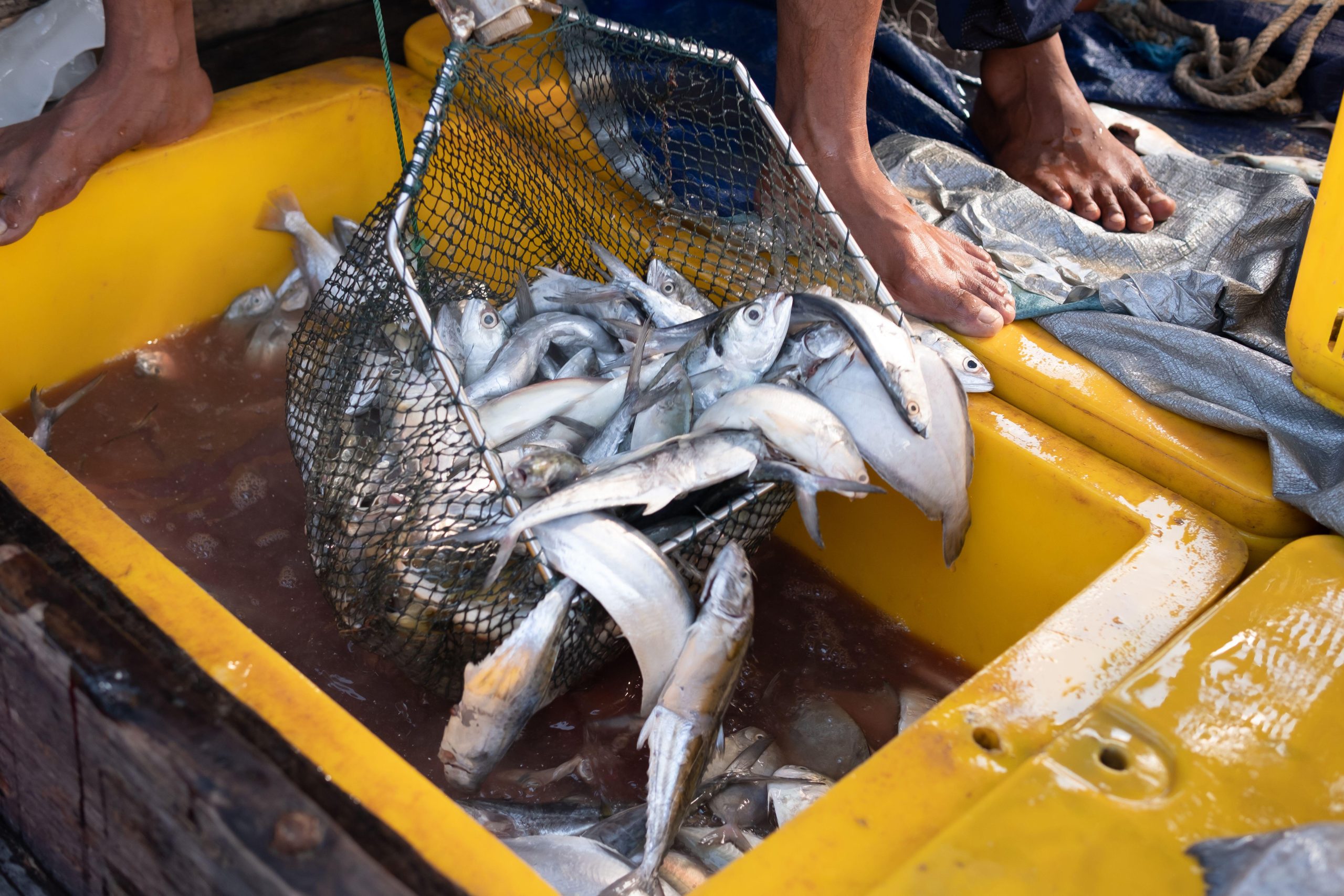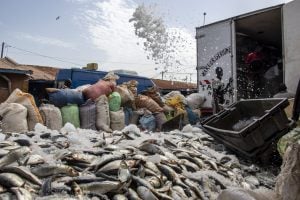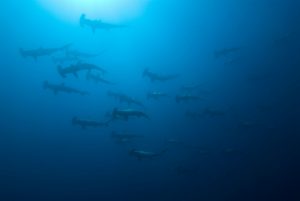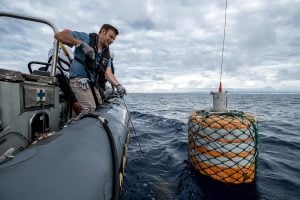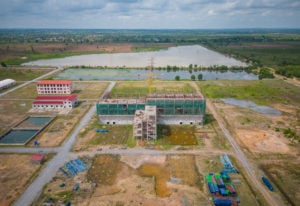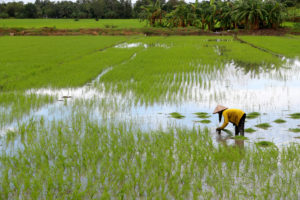Whether it’s farmed or wild-caught, tracing the journey of seafood all the way to our plates is immensely challenging. Complex supply chains that span multiple countries and dozens of companies make the industry highly opaque and rife with fraud.
Seafood is one of the most traded commodities in the world. In 2020, 178 million tonnes were caught or farmed, according to the FAO. This is set to rise to 202 million tonnes in 2030. Around three billion people worldwide rely on seafood as their primary source of protein.
But one in five fish sold worldwide are caught illegally, which in 2009 was accounted to be worth up to US$23.5 billion every year (approximately $42 billion when adjusted for inflation). The most common form of seafood fraud is to mislabel a lower-value species as a higher-value one. For example, labelling yellowfin tuna as bluefin.
According to a 2021 analysis by the Guardian, nearly 40% of 9,000 seafood products collected globally from restaurants, fishmongers and supermarkets were mislabelled. The analysis looked at 44 seafood studies, including one from 2018 that found the highest rates of mislabelling to be in the UK and Canada (55%), followed by the US (38%).
Calls for full-chain traceability
The seafood industry is facing mounting pressure to adopt full-chain traceability. According to Wendy Banta, “increased transparency equals increased accountability and assurance: being able to trace the origin of seafood products means that claims of sustainability made by companies can actually be verified.” Banta is the head of supply-chain assurance at the Aquaculture Stewardship Council, a non-profit that establishes protocol for sustainably farmed seafood.
The industry is increasingly looking to technology to verify the provenance of seafood and detect whether it has been caught in a sustainable, legal way.
For example, by analysing the natural chemical markers found in the shells, bones and soft tissue of seafood, scientists and regulators can track where a sample has come from.
China Dialogue Ocean asked the scientist Catherine Longo about these technological developments: “The biggest advantages of improvements to forensic methods being used in seafood supply chains is the precision and speed in effectively identifying risks of fraud, which include species substitution or misrepresenting their geographic origin.” Longo is the principal scientist for the Marine Stewardship Council (MSC), a non-profit that sets standards for sustainable fishing worldwide.
Trace elemental fingerprinting
Water, soil and air are full of “trace elements”, such as selenium, potassium and zinc. In turn, these elements are found in minute quantities in the soft tissue of every living organism. The concentration of these elements can be used to create an individual fingerprint for any seafood product. One study of this practice, which is known as trace elemental fingerprinting (TEF), found it to be 100% accurate in identifying the harvesting locations of blue mussel shells and soft tissues.
TEF can therefore help to confirm a seafood product’s provenance claims: seafood producers and non-profits including the Aquaculture Stewardship Council (ASC) have started using TEF, with machine learning, to combat fraudsters and improve supply chain transparency.
“ASC’s approach applies a combination of elemental profiling with advanced mathematical models,” explains Banta. “This improves the power to distinguish between samples originating from different geographical areas with a greater degree of certainty.
“Over the past decade, TEF has been used as a forensic tool to determine authenticity of a wide range of food types, including fruits, honey, and meat. More recent research has shown that it has great potential for verifying the origin of seafood products, especially farmed shrimp.”
ASC tested the technology in a pilot project in Vietnam (one of the world’s biggest shrimp producers) in 2021. The non-profit found TEF could correctly assign unlabelled samples to their farms of origin, claiming 95% accuracy.
Chemical fingerprinting
Another tool that could be used alongside TEF to combat seafood fraud and illegal fishing globally is “chemical fingerprinting”. This technology capitalises on isotopes: variants of elements with slightly different weights, which gives each isotope its own physical properties that react differently within the water cycle.
A team of University of South Australia scientists led by marine ecologist Zoe Doubleday are currently developing chemical fingerprinting. Doubleday says TEF works well for, say, distinguishing one prawn population from another. But other factors, ranging from an animal’s metabolism to the time of day, can also change the concentration of trace elements in fish and seafood. Doubleday says this makes trace elemental fingerprinting a less stable and consistent indicator of a species’ origin than chemical fingerprinting.
Doubleday and her team are developing chemical fingerprinting by focusing on oxygen isotopes. Present in shells and bones, these natural chemical markers are similar across many different marine animals. Oxygen isotopes are determined by ocean composition and temperature, rather than an animal’s biological traits, which helps determine provenance.
“An octopus, clam and a fish living in the same bay will all have the same chemical value,” explains Doubleday. “We have developed a technique to suit lots of different seafood species and a marker that is more universal to try to [establish] true geolocation.”
As technology develops to make regulation cheaper and more accessible, seafood fraud won’t be worth the riskCatherine Longo
The scientists’ method entails extracting oxygen isotopes absorbed by calcium carbonate in the shells and bones of different seafood species. Next, they use a spectrometer to analyse the isotopes’ chemical and geographical origins. Meanwhile, the team built a globe-spanning map of ocean chemistry, which allows them to match the isotope data with specific locations.
Doubleday says this method is very good for tracking animals living in different latitudes and temperatures. Using chemical fingerprinting, the researchers calculated the provenance of fish, cephalopods (such as squids and octopuses) and shellfish from either the tropical waters of Southeast Asia, or the cooler waters of southern Australia. They recorded location accuracy rates of up to 90%.
“There are obviously a lot of animals that live at similar latitudes,” reflects Doubleday. “Japan is a similar latitude to where I live in southern Australia, so these species are going to have similar values … we’re working on a novel marker now that is influenced by geology and will help us refine [such results].”
Chemical fingerprinting’s use of oxygen isotopes is what makes it a more suitable method for testing a wide range of seafood species: “With oxygen isotopes you’re analysing ratios, rather than quantities of the element.”
Scientists can analyse the ratio of light to heavy isotopes of an element found in a specific sample to determine its provenance. This ratio varies depending on climate, location and environmental conditions. “There are lots of physical laws that determine that ratio, whereas with trace elemental fingerprinting, you’re just looking at the concentration of that element,” adds Doubleday.
Scientific solutions at scale
Doubleday says chemical fingerprinting could be used by, for example, a government agency to audit seafood products at the processing stage; shells are usually discarded at this point and “could easily be archived”.
A spokesperson for the MSC tells China Dialogue Ocean the same thing, calling chemical fingerprinting an “important tool to further expand beyond limited species, so the technique can be scaled for market-wide surveillance purposes”.
In 2021, the MSC’s Longo co-authored a study that analysed the capability of chemical fingerprinting to detect where a fish was caught. According to the MSC spokesperson, the study revealed “strong potential for these techniques to be more widely used”. Currently, a “lack of empirical studies to confirm the accuracy on the water for more species and more locations” is holding the technology back.
This technology is still in its infancy and there is a long way to go before it is used in practice. The next step for the University of South Australia team is to test samples of unknown origin. Meanwhile, the scientists continue to build their global map.
It is also unclear whether tools such as chemical fingerprinting are vulnerable to changes in ocean chemistry and temperature, says Banta: “There are several variables and unknowns, one of which is climate change in the long term.” The MSC agrees: “It is necessary to continue to track the changing chemical elements that define the product profile, to ensure the accuracy of tests.”
Doubleday warns that this technology is no panacea to fight seafood fraud: “There’s no one method for all of it … multiple approaches are needed.” Other tools include DNA tracing, blockchain technology (to illuminate supply chains) and on-boat electronic surveillance equipment.
“If you’ve got the resources to put multiple approaches together to understand provenance, then you’ve got more certainty,” concludes Doubleday.
“Increased digitalisation of supply chain operations and product traceability is a strong deterrent to fraud,” says Longo. “As technology develops to make regulation cheaper and more accessible, seafood fraud won’t be worth the risk.”
